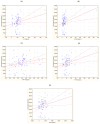Searching for New Biomarkers of Neuroendocrine Tumors: A Comparative Analysis of Chromogranin A and Inflammatory Cytokines in Patients with Neuroendocrine Tumors
- PMID: 39451760
- PMCID: PMC11506232
- DOI: 10.3390/curroncol31100456
Searching for New Biomarkers of Neuroendocrine Tumors: A Comparative Analysis of Chromogranin A and Inflammatory Cytokines in Patients with Neuroendocrine Tumors
Abstract
Neuroendocrine neoplasms (NENs) present a diagnostic challenge due to their heterogeneous nature and non-specific clinical manifestations. This study aimed to explore novel biomarkers for NENs. Serum chromogranin A (CgA) levels and a panel of 48 inflammatory cytokines were analyzed in a cohort of 84 NEN patients and 40 healthy controls using enzyme-linked immunosorbent assay (ELISA) and multiplex ELISA. Significant alterations in cytokine levels were observed in the NEN patients compared to the controls, including elevated levels of pro-inflammatory cytokines, such as interleukin (IL)-6, IL-8, and tumor necrosis factor alpha (TNF-α), and reduced levels of angiogenic factors like platelet-derived growth factor-BB (PDGF-BB) and tumor necrosis factor beta (TNF-β). Notably, cytokines such as growth-regulated alpha protein (GRO-α) and TNF-β demonstrated strong potential as diagnostic markers, with receiver operating characteristic (ROC) curve analyses showing high sensitivity and specificity. Additionally, a positive correlation was found between CgA levels and several inflammatory cytokines, suggesting their synergistic role in tumor progression. These findings highlight the limited reliability of CgA alone as a diagnostic marker and underscore the importance of a multi-marker approach in diagnosing and monitoring NENs. Further research on a larger cohort is necessary to validate these biomarkers and their potential clinical applications.
Keywords: cancer; chromogranin A; cytokines; diagnostic markers; neuroendocrine tumors.
Conflict of interest statement
The authors declare no conflicts of interest.
Figures






Similar articles
-
Alteration patterns of peripheral concentrations of cytokines and associated inflammatory proteins in acute and chronic stages of schizophrenia: a systematic review and network meta-analysis.Lancet Psychiatry. 2023 Apr;10(4):260-271. doi: 10.1016/S2215-0366(23)00025-1. Epub 2023 Feb 27. Lancet Psychiatry. 2023. PMID: 36863384
-
CD177, MYBL2, and RRM2 Are Potential Biomarkers for Musculoskeletal Infections.Clin Orthop Relat Res. 2025 Jun 1;483(6):1062-1071. doi: 10.1097/CORR.0000000000003402. Epub 2025 Feb 6. Clin Orthop Relat Res. 2025. PMID: 39915095
-
Diagnostic value of circulating chromogranin a for neuroendocrine tumors: a systematic review and meta-analysis.PLoS One. 2015 Apr 20;10(4):e0124884. doi: 10.1371/journal.pone.0124884. eCollection 2015. PLoS One. 2015. PMID: 25894842 Free PMC article.
-
CCL25 in the cerebrospinal fluid is negatively correlated with fatigue in chronic pain patients.Brain Behav Immun. 2025 Aug;128:54-64. doi: 10.1016/j.bbi.2025.03.030. Epub 2025 Mar 28. Brain Behav Immun. 2025. PMID: 40158641
-
Systemic pharmacological treatments for chronic plaque psoriasis: a network meta-analysis.Cochrane Database Syst Rev. 2021 Apr 19;4(4):CD011535. doi: 10.1002/14651858.CD011535.pub4. Cochrane Database Syst Rev. 2021. Update in: Cochrane Database Syst Rev. 2022 May 23;5:CD011535. doi: 10.1002/14651858.CD011535.pub5. PMID: 33871055 Free PMC article. Updated.
Cited by
-
Serum Concentrations of Selected Biological Factors as a Potential Tool for Detecting Recurrence in Endocrine Tumors-A Pilot Study.J Clin Med. 2025 May 26;14(11):3732. doi: 10.3390/jcm14113732. J Clin Med. 2025. PMID: 40507492 Free PMC article.
References
-
- Trofimiuk-Müldner M., Lewkowicz E., Wysocka K., Pach D., Kiełtyka A., Stefańska A., Sowa-Staszczak A., Tomaszewska R., Hubalewska-Dydejczyk A. Epidemiology of Gastroenteropancreatic Neuroendocrine Neoplasms in Krakow and Krakow District in 2007–2011. Endokrynol. Pol. 2017;68:42–46. doi: 10.5603/EP.2017.0006. - DOI - PubMed
Publication types
MeSH terms
Substances
LinkOut - more resources
Full Text Sources
Research Materials

